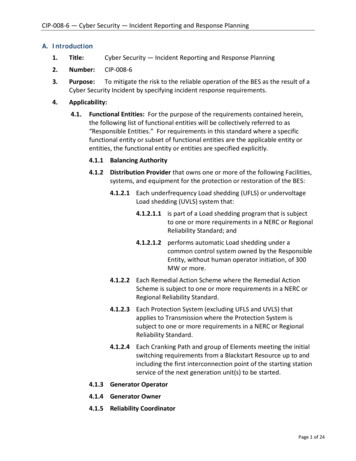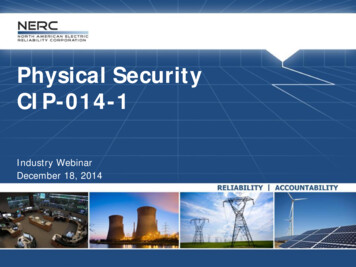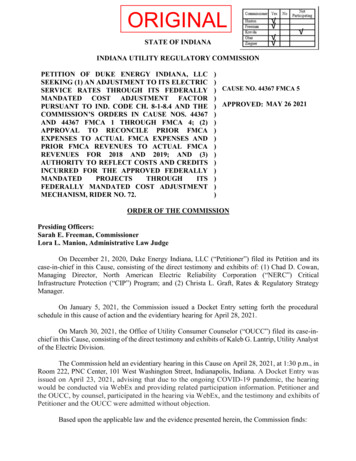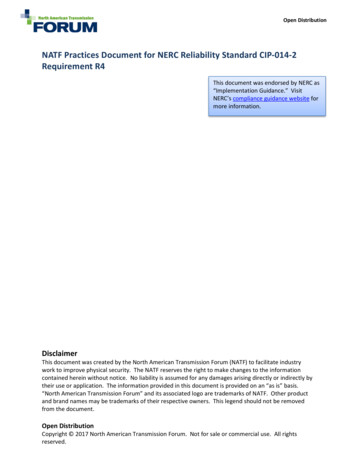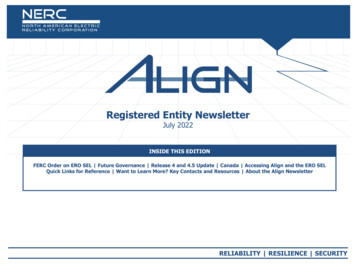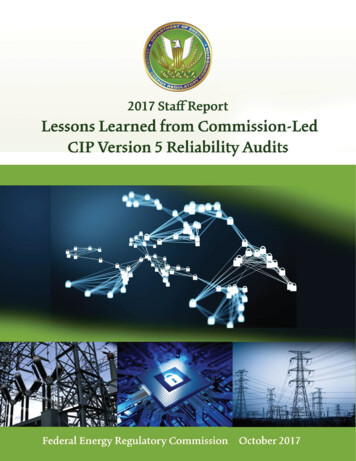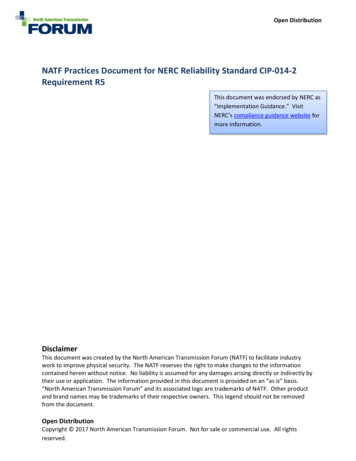
Transcription
Open DistributionNATF Practices Document for NERC Reliability Standard CIP-014-2Requirement R5This document was endorsed by NERC as“Implementation Guidance.” VisitNERC’s compliance guidance website formore information.DisclaimerThis document was created by the North American Transmission Forum (NATF) to facilitate industrywork to improve physical security. The NATF reserves the right to make changes to the informationcontained herein without notice. No liability is assumed for any damages arising directly or indirectly bytheir use or application. The information provided in this document is provided on an “as is” basis.“North American Transmission Forum” and its associated logo are trademarks of NATF. Other productand brand names may be trademarks of their respective owners. This legend should not be removedfrom the document.Open DistributionCopyright 2017 North American Transmission Forum. Not for sale or commercial use. All rightsreserved.
Open DistributionContentsReferences.2Revisions .2Section 1Purpose .2Problem Statement. 3Scope. 3Section 2Guide .4Section 3Physical Security Plan Template .11Section 4Physical Security Technologies & Resources .23Appendix 1 – Additional Resources.31Appendix 2 - Definitions Glossary of NERC-Defined Terminology .32Team Recommended Terminology . 32ReferencesNERC Reliability Standard CIP-014-2NERC Glossary of TermsRevisionsDateVersionNotesJanuary 12, 20151.0Initial Version (FINAL DRAFT)September 20, 20172.0Updated references to current standard (CIP014-2). No technical content changes.Section 1 PurposeThe purpose of this document is to provide a NERC Reliability Standard CIP-014-2 Requirement 5Practices Guide containing an agreed upon approach, common practices, and understanding for thedevelopment and implementation of Physical Security Plans.CIP-014-2 R5 Practices GuidePage 2 of 36Version 2.0
Open DistributionProblem StatementNERC CIP-014-1: Requirement 5 states:Each Transmission Owner that identified a Transmission station, Transmission substation, or primaryControl Center in Requirement R1 and verified according to Requirement R2, and each TransmissionOperator notified by a Transmission Owner according to Requirement R3, shall develop and implement adocumented physical security plan(s) that covers their respective Transmission station(s), Transmissionsubstation(s), and primary Control Center(s). The physical security plan(s) shall be developed within 120calendar days following the completion of Requirement R2 and executed according to the timelinespecified in the physical security plan(s). The physical security plan(s) shall include the followingattributes: Resiliency or security measures designed collectively to deter, detect, delay, assess,communicate, and respond to potential physical threats and vulnerabilities identified duringthe evaluation conducted in Requirement R4. Law enforcement contact and coordination information. A timeline for executing the physical security enhancements and modifications specified in thephysical security plan. Provisions to evaluate evolving physical threats, and their corresponding security measures, tothe Transmission station(s), Transmission substation(s), or primary Control Center(s).ScopeThe scope of this project was to develop a NERC Reliability Standard CIP-014-2 R5 Practices Guidecontaining agreed upon common approaches and descriptions of common terminology andunderstandings that are defensible (but not prescriptive) for developing and implementing PhysicalSecurity Plans as specified in Requirement 5. The final product includes a plan template that will assistin standardizing CIP-014 R4 R5 documentation across Forum membership. The intent is to assist andfacilitate NATF Members in developing a Best Practice document on developing and implementingPhysical Security Plans to satisfy this requirement.CIP-014-2 R5 Practices GuidePage 3 of 36Version 2.0
Open DistributionSection 2 GuideRequirement 5 - Each Transmission Owner that identified a Transmission station, Transmissionsubstation, or primary Control Center in Requirement R1 and verified according to Requirement R2, andeach Transmission Operator notified by a Transmission Owner according to Requirement R3, shalldevelop and implement a documented physical security plan(s) that covers their respective Transmissionstation(s), Transmission substation(s), and primary Control Center(s). The physical security plan(s) shallbe developed within 120 calendar days following the completion of Requirement R2 and executedaccording to the timeline specified in the physical security plan(s). The physical security plan(s) shallinclude the following attributes:The first step towards implementing Requirement 5 will be to use the results from Requirement R4(Threat & Vulnerability Assessment) in driving the planned resiliency or security measures. These will beutilized in protection against or minimization in the impact of physical attacks. Each identified threatand vulnerability must be tied to specific mitigation strategies in the physical security plan.Because of the unique nature of each facility as noted in the Standard, it is recommended that a sitespecific Security Plan be developed for each asset identified in Requirements R1 and/or R2. (A PhysicalSecurity Plan template is provided in Section 4 of this document).Physical Security plans are required to be developed within 120 days following the completion ofRequirement 2. Unlike the NERC cyber security standards, there is no requirement for the plan to beapproved and/or signed by a senior official. Although not required by the Standard, generally acceptedsecurity practices recommend that security plans be reviewed annually by an organization’s seniormanagement.Requirement 5.1 - Resiliency or security measures designed collectively to deter, detect, delay, assess,communicate, and respond to potential physical threats and vulnerabilities identified during theevaluation conducted in Requirement R4.According to the NERC CIP-014 Guidelines and Technical Basis document, resiliency may include, amongother things: System topology changes Spare equipment Construction of a new Transmission station or Transmission substation to distribute the load toseveral facilities versus concentrating in oneWhen deploying security measures for Transmission stations and Transmission substations, it shouldfirst be decided whether to harden the entire facility or specific critical assets and infrastructure withinthe facility. This may not be possible for Control Centers.While most security measures will work together to collectively harden the entire site, some may beallocated to protect specific critical components. For example, if protection from gunfire is utilized, theentity may only install ballistic protection for critical components and not the entire site.CIP-014-2 R5 Practices GuidePage 4 of 36Version 2.0
Open DistributionA critical consideration in developing a comprehensive and adequate security plan is to determine theresponse time to a physical attack. Response may come from trained personnel, a dedicated securityforce, or local law enforcement. The response time will determine the defense in depth and delaymeasures needed to protect the facility adequately. If the response resource(s) is five minutes away,the number and/or coverage of security measures deployed may be minimal. Conversely, if theresponse force is 30 minutes away, additional measures may be deemed necessary.Demonstration of implementation of the security measures deployed as specified in the PhysicalSecurity Plan may be best documented on a facility site map as an attachment or appendix to the plan.Potential generally accepted security measures for Transmission station, Transmission substation,and/or a primary control center to mitigate documented threats and vulnerabilities include:Deterrence Measures - visible physical security measures installed to induce individuals to seek otherless secure targets. Examples:Perimeter signage – Placed on the entire perimeter and at entrance points to declare “NoTrespassing” and that the facility is actively monitored, or similar messaging. Placement ofsignage should be so that all signage is clearly visible and legible from any location along theentire perimeter.Environmental Design - Companies should consider using the principles of Crime PreventionThrough Environmental Design (CPTED, see www.cpted.net). CPTED promotes the principlesthat proper design and effective use of the environment can lead to a reduction in the incidenceof crime and acts of terrorism.Fencing / walls / gates / natural barriers – The most basic outer layer of protection to deny anddelay access to a facility. All barriers of this nature are rated in method of construction,material, and time of delay, from a few seconds to minutes or hours. Fence height, material,and design may be determined by the results of Requirement 4. Where permitted the barriermay be constructed to prevent scaling of the barrier (such as topped with barbed, razor wire orfloppy top). Consideration may be given to incorporating vehicle, bullet, and blast protection ordeflection into this barrier. The barrier should be able to limit visibility, where appropriate,inside the facility and protect from the threats identified in Requirement 4. Gates may bedeployed at the same level of protection as the fence / wall / cables. Consideration may begiven to not utilizing automatic exit beams or ground sensors on gates that could be utilized byperpetrators to provide access to other perpetrators or quick exit by initiating the sensor.Consideration may be given to two or more fence lines to build in delay time, create a “deadzone” for monitoring where no motion would be anticipated and vehicle traps to preventtailgating authorized vehicles. Consideration may be given to hardware used for installation ofthese components such that the component cannot easily be disassembled/neutralized(example – most chain link fence is installed with soft aluminum wire ties, consider hardenedties or carriage bolts secured from inside instead with additional precautions to anchor andtension the lower edge).CIP-014-2 R5 Practices GuidePage 5 of 36Version 2.0
Open DistributionOn-site or Roving Security Officers/Other Trained Personnel – Armed or unarmed contracted orproprietary uniformed security officers or other trained personnel either permanently located ata site or conducting frequent periodic vehicular or foot patrols.Lighting – Security lighting enables approved personnel to maintain visual assessment capability,during the hours of darkness. Consideration may be given to maintaining unlit interior stationequipment with entry/motion/alarm controlled yard lighting for transmissionstations/substations to prevent external surveillance and potential target acquisition (creating asite through light deterrence). Lighting illumination levels may be maintained at border and/orbuffer zones integrated with surveillance systems and sufficient to support the cameraillumination specifications. Consideration should be given to collateral impacts (e.g. adjacentproperty, zoning restrictions) of the lighting systems deployed. Consideration should be given tostrobe or flashing lights in conjunction with the detection systems to communicate to anyintruder that they have been detected. In urban areas, consideration should be given to lightingthat provides minimum maintained illumination levels for pedestrian pathways, bicycle andvehicle routes, parking structures, parking lots, way finding, signage, pedestrian entrances, andbuilding services.Locks – Consider the use of a high security locking system. This could include a controlled key(assigned, logged, and monitored) with a high security lock that meets High Security Standards(such as Grade F5/S6 per the ASTM F883) and that has high security chains ( Grade 100 or highsecurity square link design). In addition, you could consider puck locks with high security haspson all entries and critical equipment access.Voice Down Capability – Consideration should be given to a voice down capability such thatwhen an alarm is generated the Security Operations Center can speak to the intruder.Detection Measures - physical security measures installed to detect unauthorized intrusion and providelocal and/or remote intruder annunciation.Examples include:Neighborhood Awareness Program / Neighborhood Watch - Awareness program created toeducate and encourage citizens to vigilantly watch around their community or property andreport suspicious behaviors or activity that may have connections to crime, as well as securitythreats to electric company facilities.Security Operations Center monitoring (SOC) – A central location from where staff manages ormonitors access control systems, video surveillance, and possibly controls lighting, alarms, andvehicle barriers for local or remote site(s) using telecommunications, security and dataprocessing technology. With the aid of technology, the electronic systems within the SecurityOperations Center or at the site detect activities of interest allowing the Security OperationsCenter staff to assess the activity and initiate the appropriate response to an incident or event.Sound Detection – Technology deployed in a substation to detect movement and orgunshots/explosives and notify the Security Operations Center.CIP-014-2 R5 Practices GuidePage 6 of 36Version 2.0
Open DistributionIntrusion Detection Systems - Physical intrusion detection is the act of identifying advancing orintruding threats. Physical intrusion detection is typically accomplished by physical controls putin place to detect entry into a defined security perimeter. Examples of physical intrusiondetections may be security guards, access control systems, mantraps, vehicle traps,motion/vibration sensors, video surveillance and other motion detection devices.Delay Measures - Physical security measures installed to delay an intruder’s access to a physical assetand provide time for incident assessment and response. Examples:Delay tactics can incorporate Crime Prevention Through Environmental Design methods – Seeabove Deter.Vehicle Barriers – Energy absorbing barriers, cable systems, technical excavations or reshapingof existing drainage to provide technical protection deployed around the perimeter may beuseful to prevent the threat of vehicle-borne improvised explosive device (car/truck bomb).Examples include:o Landscaping - berms, gullies, boulders, trees, and other terraino Hardscaping - benches and planterso Structural - walls, bollards, and cablesCritical Component Protection – Critical components within a substation may be individuallyprotected to increase the delay time required to allow for response. These may includeindividual barriers, protective coverings/coatings, or raising the critical component.Multiple Layers of Delay – This is the key concept of the protection in depth methodology.Numerous barriers deployed to slow or block an intruder’s path to the intended target.Buffer Zone Protection - A buffer zone is generally a zonal area that lies between two or moredistinct borders. In physical security terms, the area adjacent to the primary fence surroundinga substation or Control Center used to detect and/or to delay intruders, many times using thelocal terrain to the best advantage and/or deploying CPTED principles.On-site Security Officers/Other Trained Personnel – See above Deter.Fencing/walls/gates – See above Deter.Assessment Measures - the process of evaluating the legitimacy of an alarm and determining theprocedural steps required to respond. Examples:Video Surveillance – The use of cameras for video surveillance can be effective in operationalsettings. An example of pre-processed video surveillance would be the review of video historyrecorded prior to an alarm being generated, which allows Security Operations Center personnelto "see" what occurred prior to the alarm. This is an invaluable resource for Security OperationsCenter personnel during their alarm assessment prior to initiating response.CIP-014-2 R5 Practices GuidePage 7 of 36Version 2.0
Open DistributionVideo Analytics - Video analytics are the technological capability of video analysis to detect anddetermine events by utilizing the following aspects: temporal meaning time intervals, andspatial meaning space and the relationship of objects within it. The temporal and spatialalgorithms can be implemented as software on general-purpose machines or as hardware inspecialized video processing units. Video Motion Detection is one of the more simple formswhere motion is detected with regard to a fixed background scene and an alert is generated tothose responsible for monitoring. More advanced functionalities include video tracking andegomotion estimation (An example would be estimating a person's moving position relative tolines on the parking lot being observed from the person them self). Based on the internalrepresentation that video analytics generates in the device, it is possible to build otherfunctionalities (such as identification), behavior analysis, or other forms of situation awareness.Security Operations Center – See above in Detect.Communicate - Communication systems used to send and receive alarm / video signals, voice anddata information. Also, includes the documented process to communicate detected intrusions.Examples:Security Operations Center Initiates Response – Documented and exercised procedures shouldbe immediately followed to initiate response on suspected or known incidents. Allcommunications should be clear, concise, and thorough using plain language. Routine contactshould be made, in accordance with established procedures, with the Transmission OperationsCenter (TOC) to help Security Operations Center personnel determine if approved personnel areon site, if equipment alarms/events are occurring at this site or adjacent sites, or if adjacentcommunications paths have been interrupted. Information of this nature might heighten thelevel of concern regarding activity or alarms being generated at a Transmission station(s),Transmission substation(s), and primary control center(s).Signal and Data Transmission – Data transmission, digital transmission, or digitalcommunications is the physical transfer of data (a digital bit stream) over a point-to-point orpoint–to-multi-point communication channel. Examples of such channels are copper wires,optical fiber, wireless communication channels, storage media and computer busses. The datais represented as an electromagnetic signal, such as an electrical voltage, radio wave, or infraredsignal. Consideration should be given to protecting the communications path back to theSecurity Operations Center. An Uninterrupted Power Supply should be considered forcommunications and security equipment to prevent blind periods during reboot or restart, aftera power interruption or throw-over operation.Recording Methods – Many Security Operation Center’s record and time stamp all two-wayradio and telephone communications as well as surveillance system information. Recordings areespecially useful for process improvements and to assist in investigations and eventreconstructions.Alarms and Display – Consideration should be given to the configuration of the SecurityOperations Center for maximum internal visibility of all alarm and security displays withoutCIP-014-2 R5 Practices GuidePage 8 of 36Version 2.0
Open Distributionclutter, which may include having CCTV and access system alarms displayed on separate,dedicated video monitors.Intercom System - An intercom system is useful to receive communication from local andremote access points. In addition, they can be used to query unverified individuals attemptingto access or where access has been rejected (see Voice Down in Deter section).Respond - the immediate measures taken to assess, interrupt, and/or apprehend an intruder.Examples:Documented Procedures – Each organization should have documented responseprocedures to train responders and to assign responsibilities. The procedures should beregularly tested and reviewed/revised on a recurring basis.Response to Alarms - Automatic responses exclude human intervention when an alarm isreceived. Manual responses normally involve some aspect of human process before a responseis initiated.State or local Law Enforcement deployment – This will normally be the armed responding forcewhen a physical attack is underway. Coordination with and awareness by your local lawenforcement officials will be the key to rapid response. See more in Requirement 5.2 below. Apredetermined response level should be provided for various levels of events.Armed Security Officer deployment – Some organizations may have their own armed privateresponse force, subject to local laws and regulations, for responding to a physical attack.Most facilities that fall under this standard will also probably fall under the NERC cyber securitycompliance standards. Many of the strategies deployed for CIP014 will build upon and support thecyber security standard requirements.Generally, accepted security practices recommend the periodic testing of deployed security systems.Requirement 5.2 - Law enforcement contact and coordination information.A list of first responding local law enforcement, fire, emergency management and emergency medicalservices contact information for each site-specific Security Plan should be included. If military assistancemay be available, their contact information may be considered as well, and any legal or governmentalcontacts or Memorandums of Understanding [MOU] within the organization needed for their utilizationsuch as the State Emergency Management Agency and their Joint Task Force group. Contactinformation may include agency name, contact name with telephone number(s) and email address, title,and address. An alternate contact for each may be considered in accordance with corporate policies.A robust coordination program may include substation safety and familiarization training for your firstresponder contacts and familiarization tours for Control Centers. Consideration should also be given toconducting joint emergency response exercises with your contact agencies as well. If areas around theCIP-014-2 R5 Practices GuidePage 9 of 36Version 2.0
Open Distributionsites are suitable for use as staging areas during a response, those may be given consideration andidentified with the agencies. If there are specific training requirements (such as OSHA), research if theycan be waived or if training could be abbreviated for First Responders. Discuss communicationsprotocols, escalation, site access priorities vs. forensics. Ensure that BES Exceptional Circumstanceprocedures allow for their entry into any physical perimeter within the site during a response.Site tours and training of local First Responders/law enforcement may be considered when resourcesare available and the responders/law enforcement are willing. Though not required for the standard,documentation of these meetings could be recorded through agendas, dated presentations, mealreceipts with lists of attendees, and site visitor logs.Requirement 5.3 - A timeline for executing the physical security enhancements and modificationsspecified in the physical security plan.Entities have the flexibility to prioritize the implementation of the various resiliency or securityenhancements and modifications in their security plan according to risk, resources, or other factors. Therequirement to include a timeline in the physical security plan for executing the actual physical securityenhancements and modifications does not also require the enhancements and modifications becompleted within the 120-day security plan creation requirement. The actual timeline will probablyextend beyond the 120 days, depending on the amount of work to be completed. (Guidelines andTechnical Basis document) Timelines should be reasonable and recording multiple dates should beconsidered, if security or resiliency measures are deployed in phases and/or on different dates.Timelines should be modified only with the approval of management and the reasons for suchmodification documented and retained. If electrical resiliency measures are constructed to eliminatethe site from applicability under Requirements 1 and 2, those dates should be reflected in the timelineas well, if they are known.Requirement 5.4 - Provisions to evaluate evolving physical threats, and their corresponding securitymeasures, to the Transmission station(s), Transmission substation(s), or primary Control Center(s).A registered entity's physical security plan should include processes and responsibilities for obtainingand handling alerts, intelligence, and threat warnings from various sources. Some of these sourcescould include the ERO, ES-ISAC, Fusion Centers and U.S. and/or Canadian Federal and state agencies.This information may be used to reevaluate or consider changes in the Security Plan and correspondingsecurity measures of the security plan found in Requirement 5.Some mechanisms and sources for current threat information could include the following: Telephone, email or face-to-face meetings are beneficial to developing and maintainingpartnerships for current threat information. Additionally, first responder alarm response maybe discussed on a scheduled and/or recurring basis throughout the year.The ES-ISAC conducts a one-hour monthly series of webinar briefings at the ES-ISAC PRIVATE(Yellow) level of information sensitivity covering critical infrastructure protection topics withinand specific to the Electricity Sector. Representatives from the Department of HomelandSecurity’s (DHS) Industrial Control Systems Cyber Emergency Response Team and the Office ofIntelligence and Analysis discuss current events that DHS is monitoring within the ElectricityCIP-014-2 R5 Practices GuidePage 10 of 36Version 2.0
Open DistributionSector. This call is reserved for electricity sector asset owners, operators, and theirrepresentatives and agents or where the ES-ISAC has made specific invitations to guests. The ES-ISAC produces a weekly email, AOO Security Blog that is sent to electricity sector assetowners, operators, and their designated representatives and agents. Most Fusion Centers support a Terrorism Liaison Officer (TLO) program. A TLO is an identifiedperson within law enforcement, fire service, emergency management, health, military or theprivate sector that is responsible for coordinating terrorist and other criminal intelligenceinformation from their local agency to the state or regional Fusion Center. The TLO programallows agencies throughout the state to combine resources and share information, therebyproviding a clear picture for intelligence and threat analysis and allowing greater prevention,preparedness, and security efforts. The TLO is the direct point of contact for the state FusionCenter at the local level and is the key to the two-way flow of information from the TLO’s regionto the state Fusion Center.Incremental changes made to the physical security plan prior to the next required third party review donot require additional third party reviews. A registered entity’s physical security plan may includeprovisions for additional security measures or enhancements to existing measures, which could bedeployed to address an evolving or imminent threat identified through the processes in Requirement5.4. These measures could be implemented on a temporary basis during a period when there is aspecific threat or vulnerability or on a permanent basis if the threat or vulnerability is assessed to beongoing in nature.Section 3 Physical Security Plan TemplateA sample Physical Security Plan template begins on the next page. This is only a sample and may bemodified to best suit each entity’s particular needs to satisfy the requirements.CIP-014-2 R5 Practices GuidePage 11 of 36Version 2.0
Open Distribution[Company Name & Logo]Critical InfrastructureProtection[FACILITY NAME]Physical Security Plan(NERC Standard CIP-014-2)Version [#], [Date]Table of ContentsCIP-014-2 R5 Practices GuidePage 12 of 36Version 2.0
Open DistributionTable of ContentsPurpose1819Definitions . 19General . . . 19RequirementsR5 Develop and Implement a Physical Security Plan20R5.1 Resiliency and Security Measures 21R5.2 Law Enforcement Contact and Coordination24R5.3 Timeline for Executing the Enhancements 25R5.4 Provisions to evaluate Evolving Physical Threats.25Appendix A – Facility Site Map . . . .27CIP-014-2 R5 Practices GuidePage 13 of 36Version 2.0
Open Distrib
The scope of this project was to develop a NERC Reliability Standard CIP-014-2 R5 Practices Guide containing agreed upon common approaches and descriptions of common terminology and understandings that are defensible (but not prescriptive) for developing and implementing Physical Security Plans as specified in Requirement 5.
